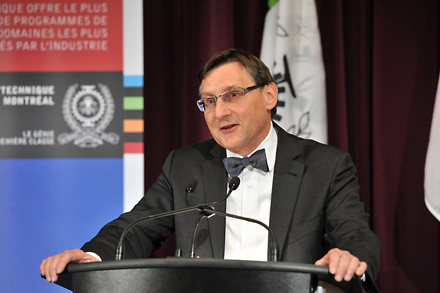
Smart grids, micro grids and artificial intelligence keeping the lights on
By McGill Reporter Staff
The biggest and most complex machine in the world is made up of tangled electrical cords under your desk, pylons lining the highway, and the monumental dams in northern Quebec.
It’s the North American electrical grid, one of the great engineering achievements of the world. And McGill’s Géza Joós is using artificial intelligence (AI) to help make this smart grid even smarter.
Quebec is blessed with an enormous capacity to generate electricity from water. Hydro-Québec has been generating, transmitting and distributing electricity for over half a century and is a world leader in the field of hydroelectricity.

With a total installed capacity of 36,908 MW (in 2016), Hydro-Québec provides a clean, renewable and reliable supply of electricity to all Quebecers. It also sells power on wholesale markets in northeastern North America.
Traditionally, the power has been generated by water and sent down the line to consumers. What’s different about today’s power grid is that some of the flow of electricity and information is now going back up to the power plant and the utility that runs it. Wind turbines and solar panels are generating power which is going back into the grid, and consumers are feeding back information to Hydro about their use of electricity.
A grid is “smart” when it has the digital technology to allow for two-way communication between the power source and its users. This Smart Grid is comprised of controls, computers, automation, and new technologies and equipment working together.
One of the challenges of the smart grid is transforming the data from a massive number of sensors into useful information that can improve power delivery. Artificial Intelligence helps find relevant patterns, allowing predictions as to when system failures are going to happen, for example, and then inform on how to make the right fix.
Professor Joós, the NSERC/Hydro-Québec Industrial Research Chair on the Integration of Renewable Energies and Distributed Generation into the Electric Distribution Grid, works on the integration challenges of many small sources of renewable energy, for example wind and solar, connected to the grid. His research activities are in the application of high-power electronics to electric power systems and power conversion, including distributed generation and renewable energy.
Joós is also the director of the Power Engineering Research Laboratory, which studies network management strategies and how these sources interface with the network.

Lab member François Bouffard was an engineering student at McGill when almost the entire island of Montreal went dark in 1998. Thousands of Montrealers were stranded in their apartment buildings and houses without light or heat. “I realized that everything was interconnected: the water system, transportation, traffic lights, and how important these systems really are,” says Bouffard, a professor in the Dept. of Electrical and Computer Engineering. “There are systems and ways to protect the electrical grid and ways to reduce the strain on the system. In my personal opinion, artificial intelligence (AI) is about using data/observations to inform decisions that are made by machines.
“In the context of power systems, this essentially entails that the quality and/or frequency of decisions made could be improved and adapted via a more rigorous use of data collected in the grid itself and other sources like weather forecasts,” continues Bouffard. “For me, the idea of adaptation of decision-making processes is quite attractive. Obviously, utilities would have to ensure the reliability of the algorithms quite thoroughly. The lights cannot go off!”
An ice storm, or other extreme weather event, falling trees, hungry rodents, a car crash – all can bring down huge sections of the grid. A hydroelectric blackout has a domino effect – a series of failures that can affect the water supply, heating, banking, communications, traffic and security.
This is a particularly serious threat in the winter, as it was in Quebec and Eastern Ontario in 1998. During the Great Ice Storm of 1998, millions of homes across Eastern Ontario, Quebec, Vermont and parts of Nova Scotia, lost power, some for weeks. At least 25 people died in Canada, most of hypothermia.
The new smart technologies will help identify problems and ensure that electricity recovery resumes quickly and strategically after an emergency. It can even route electricity to emergency services first, for example.
The Smart Grid will take greater advantage of customer-owned power generators to produce power when it is not available from utilities. By combining these “distributed generation” resources, a community could keep its health center, police department, traffic lights, phone system, and grocery store operating during emergencies. The system could be made more resilient by drawing on greater amounts of home-grown electricity that is more resistant to natural disasters and attack.
A smarter grid could enable an unprecedented level of consumer participation. For example, you wouldn’t have to wait for your monthly statement to know how much electricity you use. “Smart meters,” and other mechanisms, will allow you to see how much electricity you use, when you use it, and its cost. Combined with real-time pricing, this will allow you to save money by using less power when electricity is most expensive. The Smart Grid could help users save money by helping to manage electricity use and choose the best times to purchase electricity.
“The whole notion of smart grids boils down to the increasing presence of sensing and automation closer to where electricity is consumed,” says Bouffard. “Since the beginning of the power industry, sensing and automation have been present in various forms in high-voltage transmission and power generation systems, i.e. where significant capital investments are needed and where failures can affect a large number of consumers. The low-voltage distribution systems, where consumers are connected, were traditionally without much sensing and automation. Hence, the bulk of smart grid development is happening in the distribution networks where it is most needed.”
Joós was involved in developing expertise in small producers feeding into the grid as the first Quebec wind farms, commissioned in the late 2000’s, came online. The research program focused on the quality of service of customers close to wind power installations and reducing wind-induced flicker in lighting systems. The goal was to provide scientific support in the elaboration of grid interconnection standards for private wind producers.
Now the focus of the NSERC\ Hydro-Québec Chair has turned to addressing challenges of grid–generator interfaces, and integrating consumer-side flexibility and energy storage systems. That has led to increasing interest in smart micro grids – smaller, self-contained, interactive electrical grids that would continue to function during a larger power outage.
Micro grids are locally controlled power systems, such as university campuses, usually grid connected, but able to operate as electrical islands. The development of the smart micro grid is the subject of a symposium coming up at the Trottier Institute for Sustainability in Engineering and Design on April 25-26.
Bouffard says the work being done at McGill contributes to the advancement of the industry. Unlike Hydro-Québec, most Canadian electrical utilities do not have Research & Development arms, which means the research work at universities is essential for utilities worldwide. The other area of study is policy related – McGill contributed scientific evidence towards drafting the 2016-2030 Quebec Energy Policy.
“Current interest in micro grids is motivated by the promise that they have a better chance than the mega grid of delivering power during a disaster, and/or they can recover faster,” says Bouffard. “To achieve this however, they must have a fuel source or adequate storage. Another sector that needs power under highly adverse conditions is the military, and the military has great interest in micro grids.”
